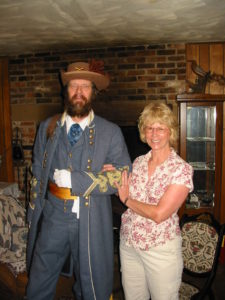
Scout Jeb Stewart with Annette Hubbell
Play Development
After a visit to Gettysburg some years ago, I was so moved by all that was around me—it seemed even the wind whispered of that fearful struggle— that I wrote a one woman performance entitled Witness to Gettysburg, and have since performed it about 200 times. My character, Hattie Elizabeth Turner, is based on a real person; every other event and person in my story is real. Hattie follows her husband to Gettysburg. On the second day of battle, young Hattie finds herself a widow. In spite of her grief, she cannot help but stay to help care for the 30,000 dead and wounded left at Gettysburg’s doorstep. What is a small town to do? What is she to do?
Witness to Gettysburg opens on the eve of the battle, the summer of 1863. Four months later, November 19, 1863, Hattie watches in awe as Mr. Lincoln stands before a congregation of 10,000 and delivers those immortal words in unmatched eloquence. His words, which continue to inspire and uplift us, bring a deep sense of appreciation for the fight endured. In Lincoln’s God-fearing, humble manner he showed a remarkable strength of character and leadership that stayed the course and saw this country through a most difficult period.
As a young man Lincoln once said: “I will study and get ready and someday my chance will come.” Indeed it did, Mr. Lincoln. He was there when this country needed him. If a child were to pick just one person to emulate, Abraham Lincoln would surely provide that child with enough examples of integrity, responsibility, honesty, perseverance, faithfulness, and humor (yes Lincoln loved to tell jokes) to last a life time.
Character Development
Our B&B offered something no other Gettysburg B&B did: actors gracing us daily with Civil War stories. Confederate scout Jeb Stuart regaled us of his exploits. A soldier taught us to fire a musket. A widow recounted her days caring for casualties. We were mesmerized, and I was hooked! Early the next morning I awoke to an epiphany: tell the story of Gettysburg back home in San Diego. What? Yes, tell it to students studying the Civil War—add depth to their study; engage their curiosity, intellect, and interest. This epiphany said make the story symbolic. Create an appreciation and awareness of what our ancestors did for us and this country. Wow. A pretty tall order.
I spoke with Chaplain Judith, the actor who portrayed Widow Hattie Elizabeth Unangst, a great, great relative. She eagerly gave me permission to use her story as I saw fit. The story needed to be compelling; one that focused on the battle yet put in the context of cultural and world affairs. One in which the character was able to stand invisibly alongside generals and soldiers so you could be there as the battle unfolds. Hattie Elizabeth Turner was born, and with it, “Witness to Gettysburg.”
In addition to a historically accurate picture of the battle and its terrible aftermath, it also tells of Hattie’s maturity into a determined, resolute, and fearless character—a woman learning to take care of herself in an era not quite ready to embrace the concept of an independent woman. One in which layers of honor and pride are peeled back to reveal the pain and astonishment of reality. And too, what happens in a battle’s wake when everyone picks up their weapons and moves on? And finally, there are many accounts of war and men. Much of war history is devoted to soldiers. What does a woman see when she looks at war?
Initially, as I said, this project was aimed at students. However, adults became interested as well and it wasn’t long before Hattie, in an expanded version, was telling her story in the theater and to civic and community organizations.
The Civil War, fought from 1861 to 1865 claimed 620,000 lives. The Battle of Gettysburg was its turning point. As Hattie says, Though the remembering can be disarming, it is important to do so. The tellings remind us to be ever vigilant in the confrontation of moral injustice, to be ever mindful of freedom’s price, and to pay our respects to those who paid such dear price.

Annette firing a musket.
I look forward to telling her story of that fearful struggle, the bloodiest battle ever to be fought on American soil.
